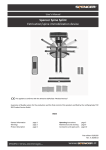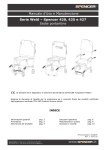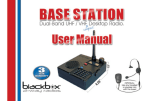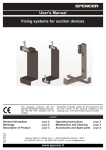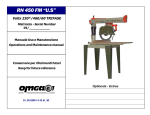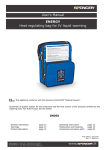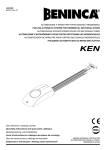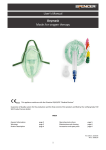Download User's Manual 20 G Fixing system for transport chairs
Transcript
User’s Manual F 400 20 G Fixing system for transport chairs This appliance conforms with the Directive 93/42/CEE “Medical Devices” Guarantee of Quality system for the production and the final control of the products certified by the notifying body TÜV SÜD Product Service GmbH INDEX General information Warnings Product description page 2 page 2 page 4 Operating instructions Maintenance and cleaning Accessories and spare parts page 5 page 7 page 8 First edition: 30/11/2009 Rev. 2: 13/05/2014 1 Thank you for choosing a Spencer product 1. GENERAL INFORMATION 1.1 Aim and contents The aim of this manual is to supply all the information necessary so that the client, will not only attain adequate use of the appliance, he will also be capable of using the instrument in the most autonomous and secure way possible. This includes information regarding technical aspects, functioning, maintenance, spare parts and safety. 1.2 Conservation of the instruction and maintenance manual The instruction and maintenance manual must be kept together with the product, for the whole life of the device, inside a dedicated container and above all, away from any substances or liquids which could compromise perfect legibility. 1.3 Symbols used Symbol Meaning General or specific warnings See instructions for use Serial number Product code The product is compliant with the specifications of the Directive 93/42/CEE 1.4 Servicing request For any information regarding the correct interpretation of the instruction manual, the use, maintenance, installation and restore of the product, please contact the Spencer Customer Care Service tel. 0039 0521 541111, fax 0039 0521 541222, email [email protected] or write to Spencer Italia S.r.l. - Strada Cavi, 7 - 43044 Collecchio (Parma) - ITALY. In order to facilitate the assistance service, please always indicate the serial number (SN) shown on the label applied on the box or on the device. 1.5 Demolition When the devices are no more suitable for being used, if they haven’t been contaminated by any particular agents, they can be disposed of as normal solid waste, otherwise follow the current regulations about demolition. 1.6 Labelling Each device has got an identifying label, positioned on the device itself and/or on the box. This label includes information about the manufacturer, the product, the CE mark, the serial number (SN). It must never be removed or covered. 2. WARNINGS 2.1 General warnings • The product must be used by trained personnel only, having attended specific training for this device and not for similar products. • Training routines must be registered on a special register in which the names of those trained, of the trainers, date and place are indicated. This register which will certify the eligibility of the operators to use the Spencer device has to be kept for a period of 10 years after the disposal of the device itself. This register will be made available to the competent authorities and/or manufacturer if requested. • Spencer Italia S.r.l. is always at your disposal to plan trainings on products. • Before carrying out any kind of operation on the appliance (training, installation, use), the operator must carefully read the enclosed instructions, paying particular attention to the correct safety precautions and to the procedures to be followed for installation and for correct use. • If the instructions belong to another device and not to the device received, inform the manufacturer immediately and avoid use of the device. • In case of any doubts about the correct interpretation of the instructions, please contact Spencer Italia S.r.l. for any necessary clarifications. • Do not allow untrained persons to help during the use of the device, because they could cause damage to the patient or to themselves. • Regularly check the appliance, carry out the prescribed maintenance and respect the average life span, as indicated by the manufacturer in this user’s manual. 2 • Before each use of device the perfect operating state of the device must be checked as specified in the instruction manual. If any damage or abnormalities which could in any way influence the correct functioning and the safety of the device, of the patient and of the user are detected, the device must be immediately removed from service and the manufacturer must be contacted. • If any failure or incorrect functioning of the device is detected, it must be immediately substituted with a similar item so that the rescue procedures are guaranteed without any interruption. • Use of the device in anyway other than described in this manual is forbidden. • Do not alter or modify in any way the appliance; any such interference could cause malfunctions and injury to the patient and/or rescuer. • The appliance must not in any way be tampered with (modification, adjustment, addition, replacement). In such cases all responsibility will be denied for any malfunctions or injuries caused by the appliance itself; moreover CE certification and product warranty will be considered void. • Those who modify or have modified, prepare or have prepared medical appliances in such a way that they no longer serve the purpose for which they were intended, or no longer supply the intended service, must satisfy the valid conditions for the introduction onto the market. • Handle with care. • Ensure that all the necessary precautions are taken in order to avoid the hazards that can arise as the result of contact with blood or body fluids. • Register and store with these instructions: serial number, place and date of purchase, first date of use, date of checks, name of users, any comments. • When the device is being used, the assistance of qualified staff must be guaranteed. • Never leave the patient unassisted on the device, because he may be injured. • Do not store the device underneath any heavy objects which could cause structural damage. • Store in a cool, dry, dark place and do not expose to direct sun. • Store and transport device in its original packaging. • The device not be exposed to or come into contact with any source of combustion or inflammable agents. • Position and adjust the device taking care not to cause any obstruction to rescuers and or any other rescue equipment. • Attention: laboratory testing, post production tests, instruction manuals cannot always consider every possible scenario for use. This means that in some cases the performance of the product could be notable different from results to date obtained. Instructions are continually being updated and are under tight surveillance of fully qualified staffs with adequate technical formation. • With reference to the D. Lgs. 24th February 1997, n. 46 emended by D. Lgs. 25/01/2010, n. 37 – Acknowledgement of Directive 93/42/CEE and 2007/47/CE, we remind both public and private operators that they are obliged to report any accident that involves any medical device to the Ministry of Health and to the Manufacture as specified and within time given by the European regulations. 2.2 Specific warnings • Establish a maintenance program and periodic testing, identifying a reference employee. The person to whom the ordinary maintenance of the device is entrusted must ensure the basic requirements foreseen by the manufacturer in the user’s manual. • All maintenance and periodic check activities must be registered and collected together with their intervention reports (see Maintenance Register) these documents have to be kept for a period of 10 years after the disposal of the device itself. This register will be made available to the competent authorities and/or manufacturer if requested. • Use only components/spare parts and/or accessories that are original or approved by Spencer Italia S.r.l. in order to carry out any operation without causing any alteration or modification to the device, otherwise we assume no responsibility for the proper functioning or damage resulting from device to the patient or the operator and warranty and will be considered void according to the compliance to the Medical Device Directive 93/42/CEE. • The device and all its components, after washing, should be allowed to dry completely before storing. • Lubrication must be carried out after cleaning and complete drying. • Avoid contact with sharp objects. • Do not use the device if it is eccessively worn out. Condensation, water, ice and accumulation of dust can affect the correct operation of the device. 2.3 Contraindications and side effects The use of this device, if used as described in this manual, does not present any contraindications or collateral effects. 3 3. DESCRIPTION OF PRODUCT 3.1 Intended use Spencer F 400 e F 400-A sono sistemi di fissaggio destinati alle sedie portantine delle Serie Profile e Weld. Questi dispositivi consentono la completa stabilità della sedia portantina all’interno del vano dell’ambulanza. Spencer F 400 and F 400-A are fixing systems dedicated to the Spencer transport chairs of the Profile and Weld Series. These devices permit a total stability of the transport chair inside the ambulance. 3.2 n° 1 2 3 4 5 6 7 Main components Description of Material component Self fastening belt Metal Fastening hooks Steel for tran sport chair Hook activation Steel pedal Screws for floor Steel fixation Hook base Steel Belt for upper Polypropylene fixation Upper profile Steel 7 1 6 2 3 5 4 Fig. A 3.3 Models These basic models could be modified, with reference to codes and/or descriptions without any previous notification. ST36451B F 400 Complete 20 G Fixing system for transport chairs ST36458B F 400-A Complete 20 G Fixing system for Avio transport chairs 3.4 Dati tecnici Characteristics Base width (mm) Base thickness (mm) Base heigth (mm) Width of upper part (mm) Thickness of upper part (mm) Heigth of upper part (mm) Weight (kg) 3.5 Reference standards Reference MDD 93/42/CEE MDD 2007/47/CEE Legislative Decree 24/02/1997, n. 46 Legislative Decree 25/01/2010, n. 35 UNI EN 1789 UNI EN ISO 14971 UNI CEI EN ISO 15223-1 UNI CEI EN 1041 CEI EN 62366 MEDDEV 2.4/1a-b NB-MED 2.5.1 /Rec 5 MEDDEV 2.7.1 MEDDEV 2.12/1 UNI EN 14155 F 400 401 72 80 480 30 60 1,9 F 400-A 335 72 80 420 30 60 1,6 Title of document European Directive about Medical Devices Modifications to 90/385/CEE Directive about active implants, Directive 93/42/CEE about medical devices and Directive 98/8/CE about the introduction of biocides onto the market Application of the 93/42/CEE Directive about Medical Devices Modifications and additions to the 20/02/97 Decree n. 46 medical vehicles and their equipment - Ambulances Application of risks managing to medical devices Medical devices - Symbols for use in the medical device labels, labelling and information to be provided. Part 1: general requirements Information supplied by the medical devices manufacturer Medical Devices - Application of the utilisation characteristics of engineering to medical devices Guideline for the classification of medical devices Technical Documentation Clinical Data Medical Devices vigilance system Clinical evaluation of the medical devices for human beings - Part 2: Clinical evaluation plans 4 3.6 Environmental conditions Functioning temperature: from -20 to +60 °C Storage temperature: from -20 to +60 °C 4. OPERATING INSTRUCTIONS 4.1 Transport and storage Before transporting the appliance, make sure that it is correctly packaged ensuring also that there are no risks of shocks, bumps or falls during the transport itself. Keep the original packaging for use in case of any further transport and for storage. Damage to the appliance caused during transport and handling is not covered by the guarantee. Repairs or replacement of the damaged parts are the responsibility of the client. The device must be stored in a dry, cool area away from direct sunlight. It must not be placed in contact with any substances or chemical agents which could cause damage and reduce safety characteristics. 4.2 Preparation On receipt of the product: • Remove the packaging and display the material so that all components are visible. • Check that all the components/pieces on the accompanying list are present. The appliance must be checked before every use so as to reveal any working abnormalities and/or damage caused by transport and/or storage. In particular, check: • General functionality of the device • Cleanliness of the device (remember that the failure of cleaning may cause the risk of cross infections) • Absence of cuts, holes, tears on the structure, including the straps • Correct fixation of all nuts, bolts and screws • State of use (moving parts) • Integrity of components • Lubrication of moving parts • Functioning of springs • Weldings are intact, without any cracks or breaks • No piping or metal sheet present bends or cracks If the above conditions are met, the device may be considered ready for use; otherwise you must immediately remove the device from service and contact the Manufacturer. 4.3 Requirements for the emergency vehicle Spencer F 400 and F 400-A have been designed for installation on an ambulance vehicle. The vehicle should have the following characteristics: • Levelled tread surface, perfectly vertical. • Tread surface long and large enough to freely house the fixing system. • In order to ensure a proper use of the fixing system, it is recommended to install it on an emergency vehicle compliant with the requirements specified in EN, 1789, otherwise the manufacturer will not be held responsible for any errors or faults generated by the fixing on an unsuitable surface. 4.4 Functioning 4.4.1 Blocking the chair to the fixing system 1. Load the transport device onto the ambulance as required for standard use. 2. Take the chair in its closed position next to the fixing system with a little inclination. 3. When the chair is next to the fixing system, rise the pedal with your foot (n°3 par 3.2) in order to allow the wheel pivots to slide under the fixing fork (n° 2 par 3.2). 4. Release the pedal and make sure that the transport chair is correctly fixed to the base of the F 400 or F 400-A (fig. C). 5. Rotate the chair until it reaches complete contact with the wall. 6. Fasten the belt (n° 6 par 3.2) making sure to maintain the chair’s handles inside its structure (fig. D lower miniature) and verifying if the belt has got enough tension so as to avoid any movement of the chiar. 7. Make sure the chiar is securely anchored by performing repeated movements of some traction. 5 Fig. B Fig. C Fig. 3 Fig. D 4.4.2 Unblocking the chair from the fixing system 1. Release the belt. 2. With your foot, action the pedal placed at the base of the fixing system in order to allow unblocking of the wheel pivots from the hook. 3. Move the transport chair towards your body and release the pedal. 4.4.3 Fixing of hook to platform The installation of the device must be performed only by trained and authorized personnel. An incorrect installation will invalidate the safety standards with which the device has been designed and built. 1. 1. Position the base of the hook at a distance between 27 mm and 30 mm from the wall D (fig. E). 2. Use the base as a die to mark the position of the fixing screws on the floor. 3. Fix the base using two screws TCEI M8 type, class of resistance 8.8 and washers Ø 8x24x2 mm. 4. The axis of the holes of the upper part of the hook must be positioned at a height H from the ground equal to 625±15 mm (fig. F). Even in this case, use the hook as a die. 5. For the fixing use two screws TCEI M8 type, class of resistance 10.9 and washers Ø 8 mm. On the opposite side of the wall use a counterplate (not supplied) and self-locking nuts M8 type. 6 H D Fig. E Fig. F 4.5 Troubleshooting PROBLEM The chair does not unblock The fixing system does not function CAUSE The release mechanism has not been operated The springs are damaged. The mechanism and/or the wheel pivots are damaged and/or worn The belt is not tight enough or is blocked The reel is not working properly Damages to the structure Improper use or not adequately trained staff REMEDY Activate the lever with your foot Put the device out of service and contact the service center Put the device out of service and contact the service center Put the device out of service and contact the service center 5. MAINTENANCE AND CLEANING 5.1 Cleaning Failure to carry out the correct cleaning routine could increase the risk of cross infection, due to presence of body fluids and/or residuals. The operator must always wear adequate personal protection such as gloves and mask etc. during all checking and cleaning procedures. The exposed metal parts are usually treated and/or painted in order to increase their resistance. Clean the exposed parts with water and delicate soap, then dry with a soft cloth. In order to obtain a shine effect, it is possible to use car waxes and creams. Do not clean with high pressure water; this will damage the joints and the lubricated parts. We recommend the use of the polishing detergent Spencer STX 99. Rinse thoroughly with warm water making sure that you have removed all traces of detergent, which could degrade or compromise the integrity and durability of the device. The use of high pressure water should be avoided. Water penetrates the joints and removes the oil, creating the risk of corrosion of components. Allow to dry thoroughly before storing. Drying after washing or after use in wet environments must be natural and not forced, do not use flames or other sources of direct heat. 5.2 Maintenance 5.2.1 Precautionary maintenance The person who carries out the precautionary maintenance of the appliance (user in person, Manufacturer/supplier or a third party) has to guarantee the following basic requirements: • Technical knowledge of the appliance and of the periodic maintenance procedures as described in these instructions. • Specific qualifications and training in the maintenance operations of the appliance in question. • The use of components/replacement parts/accessories that are either original or approved by the supplier, in such a way that each operation causes no alteration or modification to the appliance. • Possession of the checklist of operations carried out on the appliance. • Guarantee complete adherence to the instructions of the Directive 93/42/CEE which includes also the obligation towards the Manufacturer to maintain post sales records and traceability of the appliance if requested. The operator must always wear adequate personal protection such as gloves and mask etc. during all checking and cleaning procedures. Checks to be carried out before and after each use, and at least every 3 months, are as follows: • General functionality of the device • Cleanliness of the device (remember that the failure of cleaning may cause the risk of cross infections) • Absence of cuts, holes, tears on the structure, including the straps • Correct fixation of all nuts, bolts and screws • State of use (moving parts) • Integrity of components • Lubrication of moving parts • Functioning of springs • Weldings are intact, without any cracks or breaks • No piping or metal sheet present bends or cracks 7 The person responsible for routine maintenance must identify damaged/worn parts, but the replacement or restoration of them can only be carried out by the manufacturer or or by an authorized service centre. The inspection frequency is determined by factors such as legal requirements, the type of use, frequency of use, environmental conditions during use and storage. Please note that you must do the cleaning as described in paragraph 5.1 and verify functionality before and after each use. Spencer Italia S.r.l. declines any responsibility for the proper functioning or damages caused to the patient or user by the use of devices not subject to routine maintenance warranty and will void the compliance to the Medical Device Directive 93/42/CEE. 5.2.2 Periodic maintenance The device must be serviced by the manufacturer or by an authorised centre, every year If the correct revision is not carried out, the CE branding will no longer be considered valid as the product will no longer be compliant with the 93/42/CE Directive for Medical Devices and consequently it is no longer compliant with the safety standards declared by the Manufacturer at time of purchase. Spencer Italia S.r.l. will take no responsibility the incorrect functioning or any damage caused by a device that has not undergone regular revision. For any operations that are not carried out directly by the Manufacturer but by an authorised centre, we have to underline that a report regarding all operations carried out must be requested. This will permit both Spencer Italia S.r.l. and the end user to keep a log book regarding the operations carried out on the device. 5.2.3 Special servicing Only the Manufacturer or centres with written authorisation are authorised to complete any special servicing operations. For any operations that are not carried out directly by the Manufacturer but by an authorised centre, we have to underline that a report regarding all operations carried out must be requested. This will permit both Spencer Italia S.r.l. and the end user to keep a log book regarding the operations carried out on the device. The device, if used as indicated in the following instruction manual, has an average life span of 5 years. The life span can be expanded only following a general revision of the product that must be carried out by the Manufacturer or by a centre authorised by the Manufacturer. Spencer Italia S.r.l. will accept no responsibility for the incorrect functioning and/or damage caused by the use of any device which has not been repaired, or certified on expiry date by the Manufacturer or by one of the Manufacturer's Authorised Service centres, making void both the guarantee and the conformity to the Medical Devices Directive 93/42/CEE. 6. ACCESSORIES AND SPARE PARTS There are nor accessories or replacement parts for these products. 8 ATTACHMENT A – TRAINING REGISTER The product must be used only by trained personnel who have attended specific training for the use of this device and just for products with similar characteristics. Keep this document at least 10 years after the end of life of the device. Training date Operator’s name Basic training Advanced training 9 Training method (user’s manual, during service, former class, etc.) Trainer ATTACHMENT B – MAINTENANCE REGISTER Keep this document at least 10 years from the end of life of the device. Perform the required maintenance and to respect the life span of the device, as indicated by the Manufacturer in the User’s Manual. Code and description of the device Purchase date Lot (LOT) or serial number (SN) Bought by SERVICE DATE KIND OF SERVICE (Maintenance/ check/ extension of life span) OPERATIONS MADE ON THE DEVICE RESULT PERSON IN CHARGE OF SERVICE (Operator/ Authorized centre/ Manufacturer) Warning The information contained in this document could be modified without any warning and is not to be intended as a commitment on behalf of Spencer Italia S.r.l. Spencer products are exported to many countries and the same identical regulations are not always valid. For this reason there could be differences between the description here described and the product actually delivered. Spencer continually strives to reach the perfection of all items sold. We therefore hope you will understand if we reserve the right, at any time, to modify the shape, equipment, lay-out or technical aspects that are herein described. © Copyright Spencer Italia S.r.l. All rights reserved. No part of this document can be photocopied, reproduced or translated into another language without the written approval of Spencer Italia S.r.l. 10












